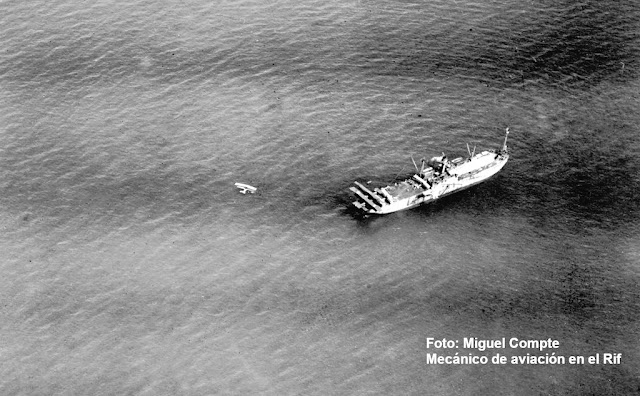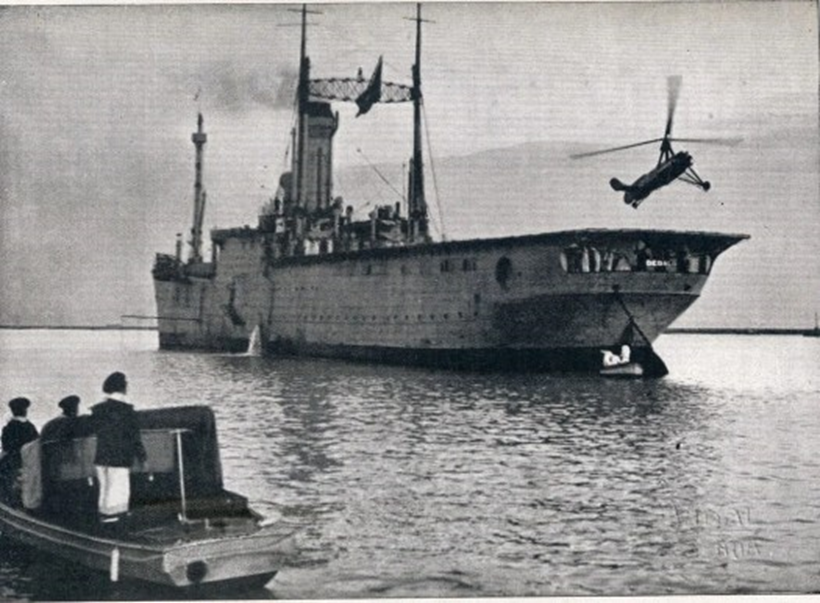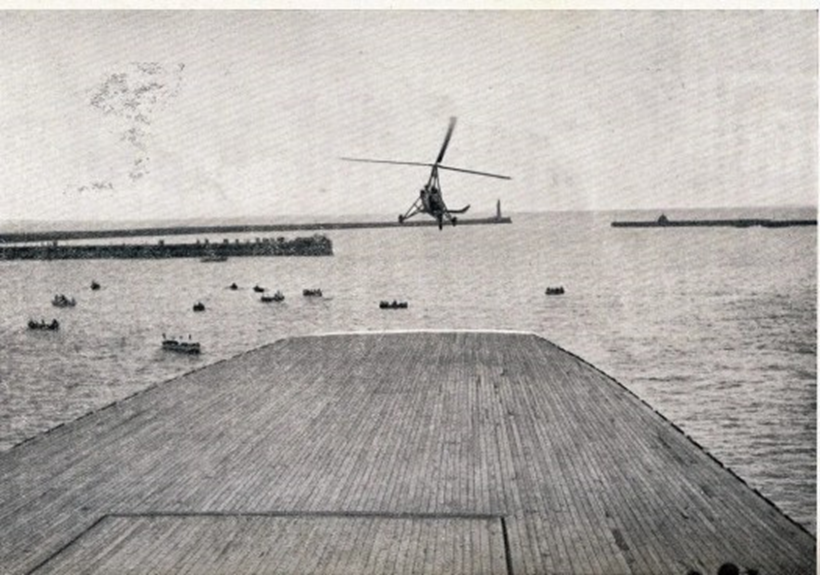Spanish seaplane tender Dedalo
The Dedalo hydroplane carrier with three Felixtowe F. 3A in the Port of Cartagena in 1920.
Built by Swan-Hunter, Newcastle and launched on April 19th 1901, then owned and operated by Deutsche Dampfs Ges and named Neuenfels out of Bremen. She was interned in Spain in 1914 early in WW1 and then later in October 1918 she was seized by Spain along with five other interned German vessels as reparations for Spanish losses during Germany`s unrestricted U-boat campaign during WW1. She gained the new temporary name "Espana No6"
On October 1st 1921, she was handed over to the Ministry of Public Works. With the war in Morocco becoming more and more serious the Spanish Navy aquired her, its naval air arm had been interested in a seaplane tender for some time and Espana No6 was just size of vessel they were looking for. She was renamed Dedalo (Spanish for Daedalus) and spent five months in Barcelona being converted at the cost of 8-million Pesetas.
It had a frankly ugly silhouette,
with a rare "anti-spark" funnel. She displaced almost 10,000 tons and had a 60-meter-long flight
deck aft of the bridge with an elevator to lower the hydros to the
hangar. The forward part was intended for ballooning, with a mooring pole
for a small semi-rigid airship and shelter for another inside the forward hold. She also had, on the port bow, moorings for
two captive balloons. Aft, on the aforementioned flight deck, they could stow, lashed to the deck against strong winds and high seas, up to a dozen seaplanes - Macchi-18s and Savoia S-16s plus some Supermarine Scarabs and inside the hangar, with
the wings folded, there was space for another twelve or thirteen aircraft of
the same types. The total capacity of the DEDALO was twenty-five seaplanes, two 1,500 cubic metre airships (of Italian design) and two captive 1,200 cubic metre balloons. There was also a hydrogen gas cylinder battery and a small production facility to supply the balloons. The Dedalo also had a number of motor boats essential for rescue and recovery operations.
The ship had a crew of 398, and could reach a speed of 10 knots. During her refit as a naval vessel she was armed with two 105mm Krupp guns forward and two 57mm guns aft.
After some basic sea trails, she carried out her first launch and recovery of an airship on April 27, 1922 and she was handed over to the navy on May 25th.
Based in Cartagena, Dédalo participated in the Rif War. Her first action was on August 6th when four of her seaplanes carried out bombing around Cebadilla Beach! She remained on active service servcie with the fleet until November 15th, her seaplanes carrying out observation, and bombing sortees; she also used her 105mm guns to fire on enemy positions.
On 20th June, 1923 the Spanish Naval Areonautics suffered theri first casualties when Lt. Vincent Cervera y Jimenez-Alfaro & Juan R.Suarez de Tangil Died when their seaplane (from Dedalo) crashed near Mahon!
Under the command of Wenceslao Benitez Inglott, took part in the largest, most successful amphibious landing before WW2 - Alchuemas Bay on September 8th 1925. Her aircraft proved highly valuable and dropped large numbers of bimbs upon enemy positions. She also supported the landings with her 105mm guns and acted and a communications vessel transmitting information seen by her ballooons to other parts of the fleet.
Supermarine Scarab
Felixtowe F. 3A
After the proclamation of the Second Spanish Republic in April 1931 she joined the Spanish Republican Navy.
In 1934 she was selected to test a revolutionary new rotary winged aircraft invented by Spanish engineer Juan de la Cierva the autogyro.
It was in Valencia , March 7, 1934, where de la
Cierva carried out landing tests with his brand new C-30 registered G-ACIO. The
aircraft landed on the Dedalo with precision, within the
marked area, and half an hour later took off again after a short takeoff run
(24m).
Even though the experiment was a complete success and many ships already in service would be easily convertable to recieve autogyros the Spanish Navy did not pursue this inovative technology.
Dedalo was decommisioned from service in 1934, she was bombed by rebel aircraft at Cartagena in April 1936 which left her abandoned there until March 1940 when she was towed to Valencia to be scrapped.















Another interesting "short" history with lots of really interesting images. Thank you for posting Richard. Carl
ReplyDeletecheers Carl, I`ve been a bit slack at posting stuff this month what with the trip to Belgium and heat making playing/modeling virtually impossible. But I can still throw together a short article :)
DeleteRichard, I know you have a talent for unusual subjects, but well researched, and well written, and much missed, vis a vis your considerable past input to the SOTCW Journal. Mind your 'enthusiasm' for all things colonial and 20th century has rubbed off, and so far this year I have submitted three historical early 20th C articles to new Sotcw Journal for publication (and a fourth which is a gaming 2nd part to one of the others). All inspired by your enthusiasm (and knowledge) of early 20th C colonial. So I shall record here that my articles are dedicated to your writing about such 'small wars'. Carl
ReplyDeleteThat is very kind, I wish you and the society all the best
DeleteOK, I have to admit I cant spot the changes!! Nonetheless great photos Richard. Interesting (and 'cigarette card' like) colour images of the aircraft. Take care in your heatwave. North Yorkshire is more 'October' like with its rain in July after our June heatwave that was very Tenerife like. If rain keeps up I will need a canoe rather than a car to get round!! All best, Carl
ReplyDeleteA few more new, interesting photos popped up on FB, so i pinched them and added them here :) We have a wedding in North Yorkshire in November I am not looking forward to the cold. :) All the best Richard
DeleteWOW! North Yorkshire in November. Could be foggy, cold and wet! But so was July this year so who knows! Flying in from Spain in November could be limited in options... Manchester... Leeds/Bradford possibly, or Newcastle. I doubt Middlesbrough / Teesside will be doing much then? If you get anywhere near Whitby with an hour to spare then drinks on me! Carl
ReplyDeleteManchester (already booked), but the wife has a whole itinerary planned - up to Cumbria to see her Uncle and cousin; then down to Sheffield where Chris is in Uni, to pick up the lads (Alex travelling there from Swansea). Then all of us head for the wedding together, the day after back to Sheffield where Alex will head home and we`ll stay for a couple of days before heading back to manchester and home. We may do a side trip to Nottingham to see my Uncle if hes up to it too :) Busy, busy :)
Delete